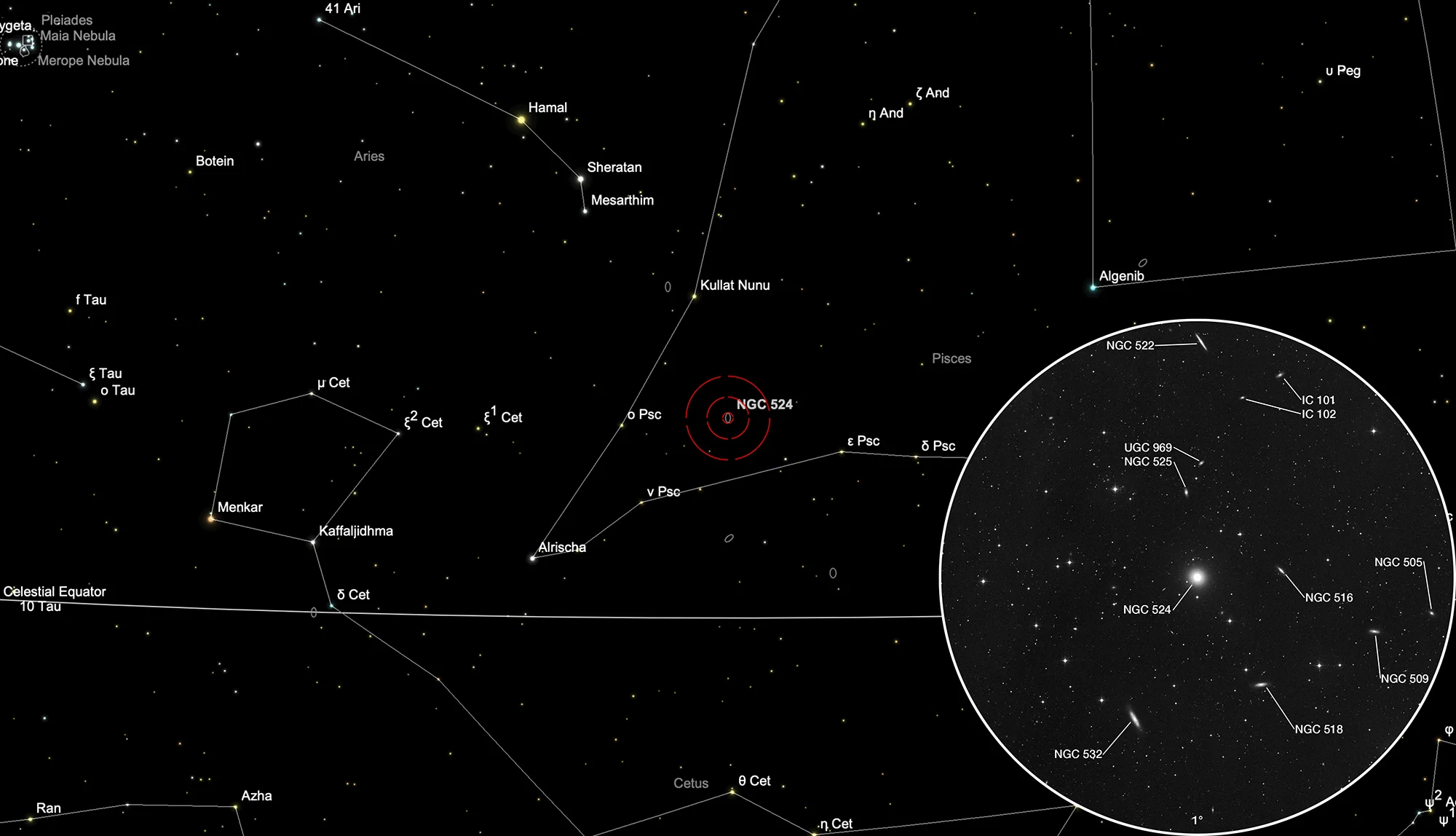NGC 524 Galaxy Group

History
William Herschel discovered the galaxies NGC 524 and NGC 532 on 4 September 1786. He listed NGC 524 as «bright nebula» I 151 with the notes: «Considerably bright, considerably large, round, cometic, very gradually much brighter middle, having a nucleus.» Galaxy NGC 532 he listed as III 556 and noted: «Very faint, much elongated, 75° south preceding north following, 1.5' long.» [464]
The galaxies NGC 516 and NGC 522 were discovered by Heinrich d'Arrest on 25 September 1862 with the 11-inch refractor at Copenhagen. Using Lassell's 48" on Malta Albert Marth discovered the galaxies NGC 505 and NGC 509 on 1 October 1864 nd NGC 518 on 11 December 1864. Stephane Javelle discovered IC 101 and IC 102 on 2 December 1893 using the 30-inch f/23 refracto at Nice Observatory. [277, 364]
Physical Properties
NGC 524 is a lenticular galaxy of morphological type S0+s. These galaxies are thought to represent an intermediate stage in galactic evolution, bridging the gap between elliptical and spiral galaxies. Spiral galaxies, characterized as middle-aged, feature sweeping, pinwheel-like arms packed with millions of stars, along with vast clouds of gas and dust. In these dense regions, new stars are born. However, as the galaxy exhausts or loses its gas into space, the prominent spiral arms gradually fade, and the distinct spiral structure diminishes. What remains is a lenticular galaxy: a luminous disc composed of old, red stars, retaining only small amounts of residual gas and dust. [702]
| Name | RA | Dec | Type | bMag | vMag | B-V | SB | Dim | PA | z | D(z) | MD | Dreyer Description | Identification, Remarks |
|---|---|---|---|---|---|---|---|---|---|---|---|---|---|---|
| NGC 505 | 01 22 57.1 | +09 28 08 | Gx (S0) | 14.8 | 13.8 | 1.0 | 13.3 | 0.9 × 0.6 | 57 | 0.018556 | 78.38 | vF, vS, stellar | GC 5170; UGC 924; MCG 1-4-41; CGCG 411-41 | |
| NGC 509 | 01 23 24.1 | +09 26 00 | Gx (SB0-a) | 14.3 | 13.4 | 0.9 | 13.2 | 1.6 × 0.6 | 85 | 0.007585 | 32.04 | vF, S, E | GC 5172; UGC 932; MCG 1-4-45; CGCG 411-43 | |
| NGC 516 | 01 24 08.0 | +09 33 07 | Gx (SB0-a) | 14.0 | 13.1 | 0.9 | 12.6 | 1.4 × 0.5 | 44 | 0.008176 | 34.53 | eF, S, v diffic, I 151 f 41s | GC 300; UGC 946; MCG 1-4-48; CGCG 411-46 | |
| NGC 518 | 01 24 17.7 | +09 19 51 | Gx (Sa) | 14.2 | 13.3 | 0.9 | 13.1 | 1.6 × 0.6 | 98 | 0.009090 | 38.40 | F, vS, R | GC 5175; UGC 952; MCG 1-4-49; CGCG 411-47 | |
| NGC 522 | 01 24 45.9 | +09 59 42 | Gx (Sbc) | 13.9 | 12.9 | 1.0 | 13.0 | 2.8 × 0.5 | 33 | 0.009090 | 38.40 | 35.000 | eF, pL, iF, ? Cl + neb | GC 305; UGC 970; MCG 2-4-38; CGCG 436-43; FGC 163; IRAS 01221+0944 |
| NGC 524 | 01 24 47.8 | +09 32 19 | Gx (S0-a) | 11.3 | 10.2 | 1.1 | 12.3 | 2.8 × 2.8 | 0.007935 | 33.52 | 25.780 | vB, pL, mbM, 4 S st nr | WH I 151; h 117; GC 307; UGC 968; MCG 1-4-53; CGCG 411-51; IRAS 01221+0916 | |
| NGC 532 | 01 25 17.1 | +09 15 51 | Gx (Sab) | 14.0 | 12.9 | 1.1 | 13.5 | 3.1 × 1 | 28 | 0.007875 | 33.26 | 29.800 | vF, pL, E 30°, bM | WH III 556; h 119; GC 313=314; UGC 982; MCG 1-4-56; CGCG 411-55; IRAS 01226+0900 |
| IC 101 | 01 24 08.5 | +09 55 50 | Gx (Sb) | 14.8 | 14.0 | 0.8 | 13.7 | 1.4 × 0.6 | 127 | 0.008019 | 33.87 | 44.400 | vF, pL, E, dif | UGC 949; MCG 2-4-36; CGCG 436-39 |
| IC 102 | 01 24 26.3 | +09 53 14 | Gx (S0-a) | 15.6 | 14.7 | 0.9 | 13.2 | 0.9 × 0.3 | 92 | 0.048100 | 203.1 | eF, S, dif | UGC 954; CGCG 436-40 |
Finder Chart
The galaxy group is located in the constellation Pisces. The best time to observe is June to March, when it is highest at night.
